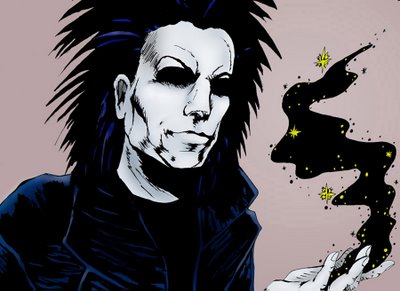I thought it would be worth reposting this – it is still how I think… (first published 29/6/2006)

I have been meaning to write this up for ages. There is much theological ore waiting to be mined in Neil Gaiman’s Sandman sequence; this may be the first of a number of posts (but don’t expect any more any time soon – the most important will be one about the nature of story and narrative identity).
The Sandman, also known as Morpheus or Dream, is one of the Endless – seven ‘beings’ or ‘anthropomorphic representations’ of aspects of creation. The story sequence begins with Dream being mistakenly captured by an Aleister Crowley type character, and the initial seven issues of the comic describe the immediate consequences of the capture – Dream’s escape and pursuit of the valuable objects taken from him – his helm, his ruby, and his pouch of sand.
The ruby eventually ends up in the hands of a madman named Doctor Destiny, who uses it to perform diabolical acts, and then to fight Dream himself. Dr Destiny drains Dream of all his power, and then destroys the Ruby, thinking that in doing so he will destroy Dream. In fact the reverse happens – all of Dream’s power and identity that had been vested in the Ruby is returned to him, and he is ‘recalled to himself’, thence easily able to overcome Dr Destiny, and return him to Arkham Asylum.
What struck me on originally reading this passage is that it is a parable for the church and the Bible.
The Church is formed by the Spirit descending at Pentecost; the community gathers for prayer and fellowship, the apostle’s teaching and the breaking of bread; it grows and strengthens around the world. Eventually it creates an object, a tool, which allows it to pursue its ministry – what we call the New Testament.
That New Testament is then taken away from the living church community (which is the only place wherein it is able to be used properly) and diabolical consequences result. In particular, the Bible is taken into the academic community, and is used to make dark materials which are destructive of the church. The academic community has now, in effect, destroyed the Bible that it originally took from the church.
Yet it seems that what is now opening up is a possibility of the church being able to return to its divine origins, to allow the Bible to be what it always was – the principal tool of the church, not something of divine origin in and of itself – the Bible can return to what it is, and the church can return to what it is: the Body of Christ in the world.
[Mad Priest’s Pre-Biblical Movement prompted me to put this up.]
